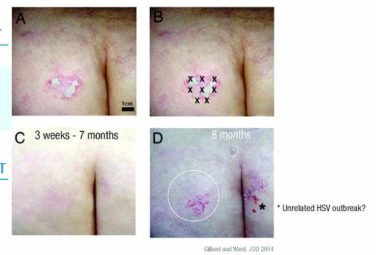AT THE ANNUAL MEETING ON WOMEN’S CANCERS
NATIONAL HARBOR, MD. (FRONTLINE MEDICAL NEWS) – Patients with early cervical cancer with negative sentinel lymph node biopsy who did not receive pelvic lymphadenectomy experienced less postsurgical morbidity than patients who underwent lymphadenectomy, with no drop in overall or recurrence-free survival, investigators report.
In SENTICOL2 , a 30-center prospective randomized study that compared sentinel lymph node (SLN) biopsy alone with SLN biopsy plus pelvic lymph node dissection for patients with early cervical cancer, recurrence-free survival at 3 years was 92% for patients receiving SLN only, compared with 95% in patients who had pelvic node dissection.
Overall survival at 3 years was 98% for the SLN-only patients, compared with 99% for those who had pelvic node dissection. None of these differences were statistically significant, and there were no significant differences between the study arms’ non-censored progression-free and overall survival rates at 6 years, Patrice Mathevet, MD, reported at the annual meeting of the Society of Gynecologic Oncology.
The study’s primary objective, said Dr. Mathevet , professor of obstetrics and gynecology at the University of Lausanne, Switzerland, was to compare the surgical morbidity experienced in each study arm, including quality of life and lymphedema–related signs and symptoms. A secondary objective was to assess and compare both overall survival and the 3-year recurrence-free rate for each study arm.
Patients were included if they had cervical cancer at International Federation of Gynecology and Obstetrics stage IA, IB1, or IIA1, with no sign of regional or distant metastases. Pregnant patients were excluded.
SLN scintigraphy was performed using the combined technetium and patent blue dye method. Patients with no identified or unilateral SLNs were excluded from the study and underwent pelvic lymph node dissection, as were patients in whom SLN scintigraphy was not performed.
Once SLNs were identified for the remaining patients, any patients with SLN metastases found on frozen section were excluded as well, while patients with grossly non-suspicious nodes and those with negative nodes on frozen section were randomized to receive just SLN biopsy with or without hysterectomy, or to receive pelvic lymph node dissection with or without hysterectomy.
SLNs in both study arms were examined by 200 micrometer serial sectioning with immunohistochemistry. For the pelvic node dissection arm, the nodes were submitted for pathology examination according to the study institution’s standard of care.
Over a 40-month period from March 2009 to July 2012, 267 patients with early cervical cancer were recruited. In the end, 206 patients were included in the study and 61 patients with positive or absent SLN results became ineligible according to the protocol criteria.
Of the eligible patients, 105 were randomized to the SLN biopsy–only arm, while 101 were allocated to the SLN biopsy plus pelvic lymph node dissection arm. Taking both study arms together, the median number of SLNs taken was three per patient, with a median one node per side.
When Dr. Mathevet and his colleagues looked at pathology from the pelvic lymph node dissection arm, they found that there were no false negatives, meaning that all patients with negative SLNs also had negative pelvic nodes.
Patient quality of life as assessed by the Short Form Health Survey (SF-36) was significantly lower for patients who received pelvic lymph node dissection. Lower extremity lymphedema signs and symptoms were also more common in patients who had pelvic lymph node dissection, indicated by the larger mean mid-thigh circumference and more common patient-reported leg heaviness and leg fatigue in the pelvic node dissection group.
The lymphedema findings were encapsulated in a global lymphatic morbidity score of 33 for the SLN-only group, compared with 52 for the pelvic node dissection group (P = .0046).
“Sentinel lymph node biopsy may improve the management of early cervical cancer, as sentinel lymph node biopsy alone induced less surgical morbidity than full pelvic lymph node dissection,” said Dr. Mathevet.
Patients were followed for a mean of 51 months post-procedure, with a total of 16 patients lost to follow-up. Patients in the SLN-only arm had a total of 11 recurrences, of which 5 were metastatic, 4 were local, and 2 were pelvic nodal. One of the pelvic nodal recurrences led to the patient’s death.
In the patients receiving pelvic node dissection, there were four metastatic and two local recurrences, but the difference in recurrence rates between the two groups was not statistically significant.
“This study leads to the morbidity-sparing approach in cervical cancer treatment while omitting the full pelvic lymph node dissection if the sentinel lymph nodes are negative,” said Dr. Mathevet.
Dr. Mathevet reported no relevant conflicts of interest.
On Twitter @karioakes





